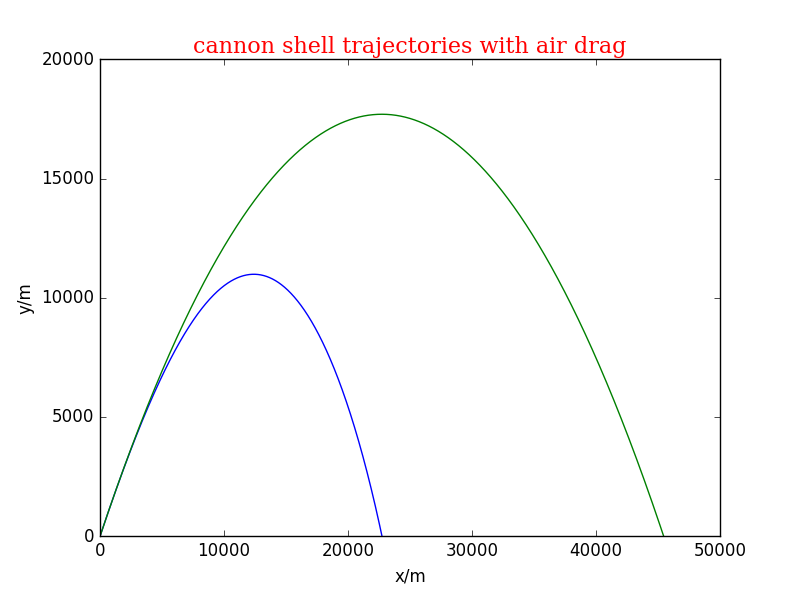@842001323
2016-10-16T16:08:57.000000Z
字数 4425
阅读 306
No.5
摘要:用不同的空气密度模型来计算加农炮的炮弹运动轨迹。也可将B2的值和温度联系起来获得不同的曲线。观察adiabatic模型对射程的影响,温度对于曲线的影响
背景
炮弹在空中飞行受到重力与空气阻力的影响
通过这几个式子可解得:
又空气密度会随高度改变,有两个模型
(1)
(2)
根据两个模型,有
将以上公式,即可进行编辑代码。
正文
- 采用第二个模型进行编码 取time_step=0.01 ,angle=1, initial_v=700, T0=273
代码
import math import pylab as pl class cannon_shell1: def __init__(self, time_step=0.01 ,angle=1, initial_v=700, T0=273, b=0.0065, Bm=0.00004,g=9.8,c=2.5,y0=10000): self.y = [0] self.x = [0] self.t = [0] self.ang = angle self.v = [initial_v] self.vx =[initial_v*math.cos(self.ang)] self.vy =[initial_v*math.sin(self.ang)] self.b = b self.Bm = Bm self.T0 = T0 self.dt = time_step self.g=g self.c=c self.y0 = y0 def run1(self): _time=0 while (self.y[-1]>=0): self.vx.append(self.vx[-1]-self.Bm*self.dt*self.v[-1]*self.vx[-1]*(1-self.b*self.y[-1]/self.T0)**self.c) self.vy.append(self.vy[-1]-self.g*self.dt-self.Bm*self.dt*self.v[-1]*self.vy[-1]*(1-self.b*self.y[-1]/self.T0)**self.c) self.y.append(self.y[-1]+self.vy[-1]*self.dt) self.x.append(self.x[-1]+self.vx[-1]*self.dt) self.v.append(math.sqrt(self.vx[-1]*self.vx[-1]+self.vy[-1]*self.vy[-1])) self.t.append(_time) _time+=self.dt def show_results(self): font = {'family': 'serif','color': 'darkred','weight': 'normal','size': 16,} pl.plot(self.x, self.y) pl.title('cannon shell trajectories with air drag', fontdict = font) pl.xlabel('x/m') pl.ylabel('y/m') pl.ylim(0,12000) a = cannon_shell1() a.run1() a.show_results() pl.show()- 相应图像

- 同时考虑两个模型 在原程序后去掉输出项,重新加上新的定义函数,最后总输出。初始值不变。
代码
class cannon_shell2: def __init__(self, time_step=0.01 ,angle=1, initial_v=700, T0=273, b=0.0065, Bm=0.00004,g=9.8,c=2.5,y0=10000): self.y = [0] self.x = [0] self.t = [0] self.ang = angle self.v = [initial_v] self.vx =[initial_v*math.cos(self.ang)] self.vy =[initial_v*math.sin(self.ang)] self.b = b self.Bm = Bm self.T0 = T0 self.dt = time_step self.g=g self.c=c self.y0 = y0 def run2(self): _time=0 while (self.y[-1]>=0): self.vx.append(self.vx[-1]-self.Bm*self.dt*self.v[-1]*self.vx[-1]*math.exp(-self.y[-1]/self.y0)) self.vy.append(self.vy[-1]-self.g*self.dt-self.Bm*self.dt*self.v[-1]*self.vy[-1]*math.exp(-self.y[-1]/self.y0)) self.y.append(self.y[-1]+self.vy[-1]*self.dt) self.x.append(self.x[-1]+self.vx[-1]*self.dt) self.v.append(math.sqrt(self.vx[-1]*self.vx[-1]+self.vy[-1]*self.vy[-1])) self.t.append(_time) _time+=self.dt def show_results(self): font = {'family': 'serif','color': 'darkred','weight': 'normal','size': 16,} pl.plot(self.x, self.y) pl.title('cannon shell trajectories with air drag', fontdict = font) pl.xlabel('x/m') pl.ylabel('y/m') pl.ylim(0,12000) a = cannon_shell1() a.run1() a.show_results() b = cannon_shell2() b.run2() b.show_results() pl.show()- 图像

绿色为模型一,蓝色为模型二,可看出两者的差距还是很大的。 - 用代替 取T=300K T0=273K
代码
class cannon_shell3: def __init__(self, time_step=0.01 ,angle=1, initial_v=700, T0=273, b=0.0065, Bm=0.00004,g=9.8,c=2.5,y0=10000,T=300): self.y = [0] self.x = [0] self.t = [0] self.ang = angle self.v = [initial_v] self.vx =[initial_v*math.cos(self.ang)] self.vy =[initial_v*math.sin(self.ang)] self.b = b self.Bm = Bm self.T0 = T0 self.T = T self.dt = time_step self.g=g self.c=c self.y0 = y0 def run3(self): _time=0 while (self.y[-1]>=0): self.vx.append(self.vx[-1]-(self.Bm*(self.T0/self.T)**self.c)*self.dt*self.v[-1]*self.vx[-1]*(1-self.b*self.y[-1]/self.T0)**self.c) self.vy.append(self.vy[-1]-self.g*self.dt-(self.Bm*(self.T0/self.T)**self.c)*self.dt*self.v[-1]*self.vy[-1]*(1-self.b*self.y[-1]/self.T0)**self.c) self.y.append(self.y[-1]+self.vy[-1]*self.dt) self.x.append(self.x[-1]+self.vx[-1]*self.dt) self.v.append(math.sqrt(self.vx[-1]*self.vx[-1]+self.vy[-1]*self.vy[-1])) self.t.append(_time) _time+=self.dt def show_results(self): font = {'family': 'serif','color': 'red','weight': 'normal','size': 16,} pl.plot(self.x, self.y) pl.title('cannon shell trajectories with air drag', fontdict = font) pl.xlabel('x/m') pl.ylabel('y/m') pl.ylim(0,20000) a = cannon_shell1() a.run1() a.show_results() b = cannon_shell3() b.run3() b.show_results() pl.show()- 图片
 绿色为改变B2后
绿色为改变B2后
图像的变化很大,程序应该存在问题,改变T0=299.1 得到图像
此时图像变化不大,T0改变了0.1,可能数据的取值存在问题。 - 对于模型(2),改变初始速度角度,观察量程的变化。angle依次为0.5、0.6、0.7、0.8、0.9、1弧度

由图像可以看出在0.7~0.8之间取值可以达到最大量程- 对于模型(1),改变初始速度角度,观察量程的变化。angle依次为0.5、0.6、0.7、0.8、0.9、1弧度

由图像可以看出在0.7~0.8之间取值可以达到最大量程- 与温度相关的曲线因为程序有些问题所以没有绘出。
结论
密度模型,温度,发射角度对轨迹的影响都很大。将两模型的轨迹进行比较,可知模型二的射程较小,模型一能达到更远的距离。当发射角度在0.7~0.8弧度之间时,射程最大。
致谢
老师提供的部分代码
